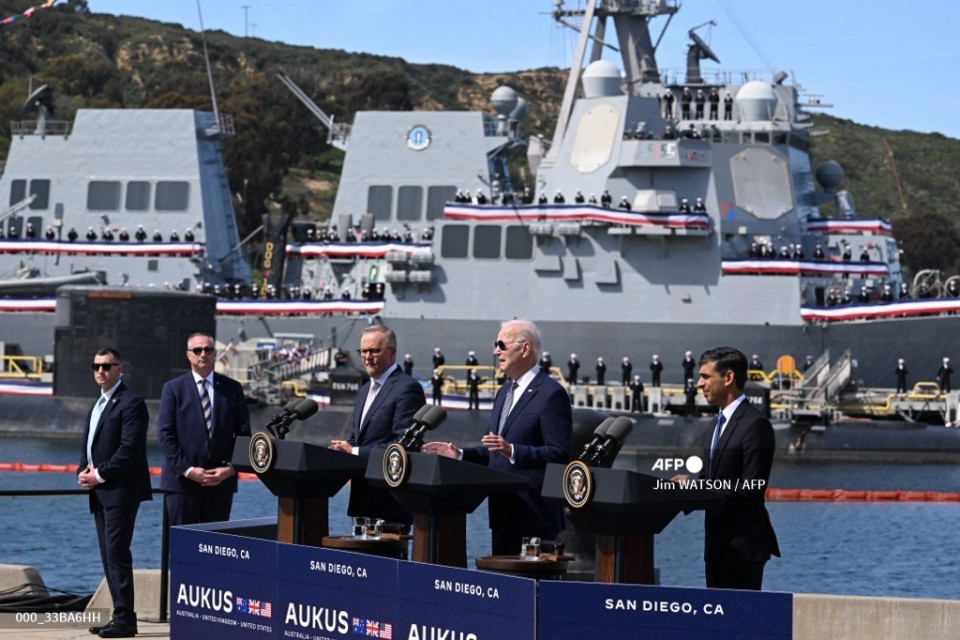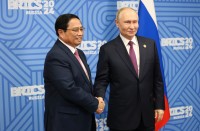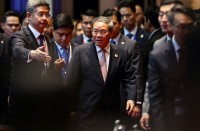
San Diego, United States | AFP |
by Jim Watson with Sebastian Smith in Washington
Australia has unveiled plans to buy up to five US nuclear-powered submarines, then build a new model with US and British technology under an ambitious plan to bulk up Western muscle across the Asia-Pacific in the face of a rising China.
The announcement came Monday at an event at a San Diego, California, naval base where President Joe Biden hosted Australian Prime Minister Anthony Albanese and British Prime Minister Rishi Sunak.
With a US Virginia-class nuclear submarine moored behind the trio’s podium, Biden said the United States had “safeguarded stability in the Indo-Pacific for decades” and that the submarine alliance would bolster “the prospect of peace for decades to come.”
As Biden stressed, Australia, which joined a newly formed alliance known as AUKUS with Washington and London 18 months ago, will not be getting nuclear weapons.
However, acquiring stealthy submarines powered by nuclear reactors puts Australia in an elite club and at the forefront of US-led efforts to push back against Chinese military expansion.
Albanese said the deal represents the biggest single investment in Australia’s defense capability “in all of our history.”
The submarines are expected to be equipped with cruise missiles that can strike foes from long distances, offering a potent deterrent to would-be attackers.
Albanese predicted that the wider economic impact at home would be akin to the introduction of the automobile industry in the country after World War II.
The Australian government estimates the multi-decade project will cost almost $40 billion in the first 10 years, and create an estimated 20,000 jobs.
Albanese underlined that Australia was now only the second country, after Britain, to be granted access to US naval nuclear secrets. “We are bound, above all, by a world … where peace and stability and security ensure greater prosperity,” he said.
Three conventionally armed, nuclear-powered Virginia class vessels will be sold “over the course of the 2030s,” with the “possibility of going up to five if that is needed,” Biden’s national security advisor, Jake Sullivan, said.
Britain and Australia will then embark on building a new model, also nuclear-powered and carrying conventional weapons, dubbed the SSN-AUKUS. This will be a British design, with US technology, and “significant investments in all three industrial bases,” Sullivan said.
– Defense spending on the rise –
While Australia has ruled out deploying atomic weapons, its submarine plan marks a significant new stage in the confrontation with China, which has built a sophisticated naval fleet and turned artificial islands into offshore bases in the Pacific.
In the face of the Chinese challenge — and Russia’s invasion of pro-Western Ukraine — Britain is also moving to beef up its military capabilities, Sunak’s office said Monday.
More than $6 billion in additional funding over the next two years will “replenish and bolster vital ammunition stocks, modernize the UK’s nuclear enterprise and fund the next phase of the AUKUS submarine program,” Downing Street said.
Australia had previously been on track to replace its aging fleet of diesel-powered submarines with a $66 billion package of French vessels, also conventionally powered.
The abrupt announcement by Canberra that it was backing out of that deal and entering the AUKUS project sparked a brief but unusually furious row between all three countries and their close ally France.
Compared to the Collins-class submarines due to be retired by Australia, the Virginia-class is almost twice as long and carries 132 crew members, not 48.
However, the longer-term upgrade will require a long wait.
A senior US official said that the British navy should get its “state of the art” SSN-AUKUS vessels in the late 2030s and Australia only in the early 2040s.
In the meantime, Australian sailors, engineers and other personnel will be training with their US and British partners to acquire expertise, while British and US submarines make regular visits to Australian ports.
China warned that AUKUS risks setting off an arms race and accused the three countries of setting back nuclear nonproliferation efforts.
“We urge the US, the UK and Australia to abandon the Cold War mentality and zero-sum games, honor international obligations in good faith and do more things that are conducive to regional peace and stability,” Chinese foreign ministry spokeswoman Mao Ning told reporters in Beijing.
The communist country’s leader, Xi Jinping, made a fiery statement last week accusing the United States of leading a Western effort at “all-round containment, encirclement and suppression of China.”
But Washington says Beijing is alarming countries across the Asia-Pacific with its threats to invade the self-governing democracy of Taiwan, as well as highlighting the threat from nuclear-armed North Korea.
“What we’ve seen is a series of provocative steps that China has undertaken under the leadership of Xi Jinping over the last five to 10 years,” the senior US official said. “This is an attempt to defend and secure the operating system of the Indo-Pacific.”
© Agence France-Presse








